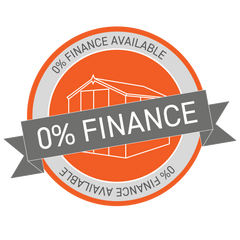Connecting your shed to the internet can transform a simple garden building into a fully functional extension of your home, making it a more productive and enjoyable space to use all year round.
Here are some of the best methods to get online in your garden shed.
Connecting a shed to the internet, at a glance:
- Assess the location of your shed before choosing a connection method
- Check your existing WiFi range before investing in extenders or cabling
- Consider a point-to-point system
- Run an ethernet cable to your shed
- Use a powerline adapter
- Try mobile internet and tethering options
- Invest in a satellite internet service
1. Assess the location of your shed
Before you choose the best method to connect your garden building to the internet, it’s important to consider a few key factors:
- The distance between your house and the shed
- The internet speed you need for work, streaming or browsing
- Potential obstacles such as walls, trees or interference
- Whether your shed has a power supply for internet devices
2. Check your existing wifi range

Before investing in extra equipment, test whether your existing home WiFi signal reaches your shed. Newer routers are more powerful than older models, so if yours is outdated, try an up-to-date device – your internet provider might even be willing to offer a free upgrade.
Relocating your router closer to your garden might help, but bear in mind that walls, insulation, trees and even glass doors and windows can weaken the signal.
A basic option for improving coverage is a WiFi extender, which rebroadcasts the signal from your home router. These are relatively inexpensive, easy to set up and might work well if your shed is relatively close to the house. However, they don’t increase speed, just range – so if your home WiFi is slow, an extender won’t solve the problem.
3. Consider a point-to-point system
For a more reliable wireless connection, a point-to-point system is worth considering. These systems use two directional units – one attached to your house and the other to your shed – to transmit a direct, stable signal. More advanced models include features like noise analysis, which helps identify interference sources.
All things considered, point-to-point systems are a good choice for those who need a stronger and more consistent connection. However, they are more expensive than WiFi extenders. They also require a clear line of sight between units, and can be affected by interference from trees, walls or other obstacles. Setup can also be more complex.
4. Run an ethernet cable to your shed

For the best reliability and speed, running an ethernet cable to your shed is a solid choice. If you’re already planning to install an electricity supply, it makes sense to lay an ethernet cable at the same time.
This method ensures a fast and uninterrupted connection, perfect for home offices or workshops where stability is key. However, it’s not the simplest solution as it requires work.
If you do decide that ethernet is the way to go, a shielded Cat6 cable is recommended to prevent interference from power lines. The cable should be buried deep enough to avoid accidental damage from garden digging, and clearly marked with permanent signage.
5. Use a powerline adapter

A powerline adapter offers a simple way to extend your internet connection without running cables across the garden. It works by sending the signal through your home’s electrical wiring. One adapter is plugged into a socket near your router and connected via ethernet, while another is plugged into a power outlet in your shed.
This method only works if your shed is powered from the same consumer unit as your house. If your shed has a separate electrical circuit, a powerline adapter won’t be compatible.
Entry-level adapters start at around £40 or less, but higher-end models offer faster speeds and better reliability.
6. Try mobile internet and tethering options

If your shed is too far from your house for WiFi or cabling, mobile internet might be a good alternative.
The easiest option is to use your smartphone’s hotspot feature, which allows other devices to connect via your mobile data. This is especially simple if you have unlimited data as part of your contract, but if you have a monthly allowance or a pay-as-you-go phone, this will be limiting and costly.
For a more permanent setup, a dedicated 4G or 5G router provides a stable connection without relying on your phone. These routers require a SIM card with a data plan and work similarly to home broadband. Speeds depend on your mobile network coverage, but 5G offers excellent performance in areas with strong signal strength.
7. Invest in a satellite internet service
For those in rural or remote locations where traditional broadband solutions aren’t feasible, Starlink and other companies offer a satellite-based service, which delivers high-speed internet anywhere in the world – including hard-to-reach garden offices or workshops.
Satellite broadband is now available across most of the UK, though some areas – particularly in the south east – have capacity constraints, leading to temporary pauses in accepting new residential customers. However, several companies are actively expanding the network by launching more satellites and improving infrastructure, with coverage and capacity set to improve throughout 2025 and beyoond.
This service doesn’t come cheap, however, and can be expensive compared to standard broadband solutions.
The benefits of connecting your shed to the internet
Whether you have a simple storage shed, an office cabin, a relaxing summerhouse or a home gym, connecting your garden building to the internet unlocks a world of possibilities:
- Create a dedicated work-from-home space – a connected garden office allows you to attend video meetings, send emails and work efficiently with all your personal devices.
- Enjoy entertainment on demand – stream music, podcasts or videos while you work, unwind or exercise. A strong internet connection means no buffering or dropped signals.
- Enhance security – connect smart cameras, motion sensors or alarms to keep an eye on your shed and garden, even when you're not there.
- Control smart devices – install smart lighting or heating that you can control remotely, improving both convenience and energy efficiency.
Adding an internet connection can help you get the most from your shed, whether you’re intending to use it for work, hobbies or entertainment. Visit our blog to discover lots of other ways to expand the potential of your shed.
MORE HELP
Visit the Waltons help pages or the Waltons garden building how-to guides for advice, tips, and all things sheddie.




